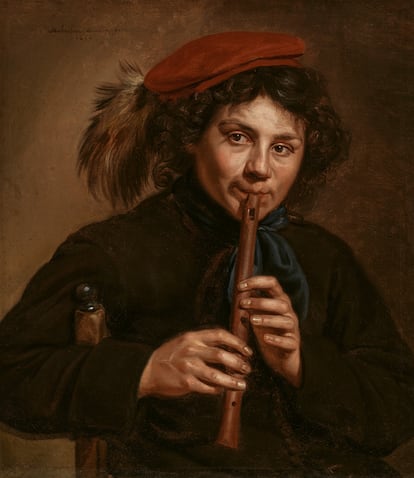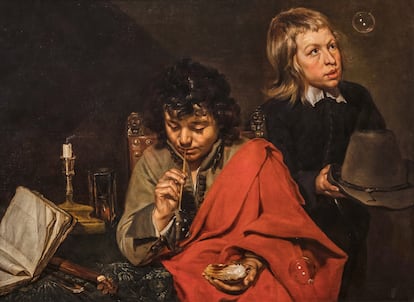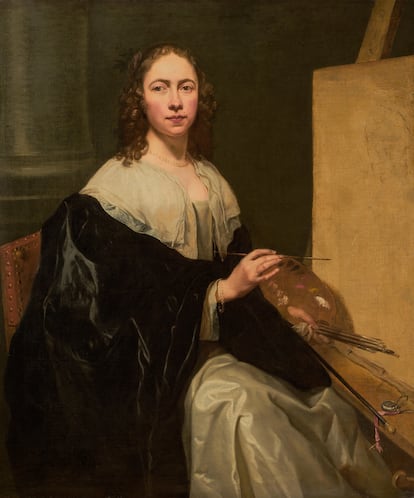For centuries experts considered that Baco’s triumph, Michaelina Wautier’s masterpiece, a seventeenth -century baroque painter, could not have been executed by a woman. First, because they thought it was a picture too big and complex so that it would have been commissioned to an artist at that time, much less with a mythological theme and, above all, because it showed male nudes made clearly – by the thoroughness of anatomical details – in a study with real models, which seemed impossible for a woman in the seventeenth century. Only since 2014, after a restoration, occupies a place of honor in the Kunsthistorisches Museum in Vienna collection, in the same room as its contemporary Rubens and Van Dyck.
This fall, from Tuesday to February 22, the Viennese Museum, one of the most important in Europe, comparable to the Prado or the Louvre, dedicates its main sample, curated by Gerlinde Gruber and Julien Domercq, to this woman on which there are hardly any biographical data, whose life remains a huge unknown, but whose work has gained prestige over the years and has finally found in the twentieth century, The space that corresponds to the history of art. There are only 35 paintings unanimously attributed to Wautier and 31 can first be seen in the Viennese Museum (which took over the press trip for the presentation) and then in the Royal Academy of Arts in London.
Now no one doubts the attribution of Baco’s triumph To the painter, Among other things because his portrait appears, on the right side of the painting, looking at the viewer challenging, with a chest discovered and characterized as a bacante. It is a self -portrait that strangely remembers the Judith of Klimt that can be seen in the Belvedere in Vienna. Michaelina Wautier was an artist who broke molds in her time and continues to break them in ours. “The way it paints men is not preceded,” the greatest specialist in La Pintora, Katlijne Van der Stighelen, professor of art history at the University of Leuven at the press at Vienna. “Michaelina had an older brother, Charles, also a painter, and surely he could work in his study with real models. His technical expertise was huge and demonstrated a very large culture because of the variety of themes he chose. Without a doubt, she was much better painter than her brother.”
Two details show to what knowledge about Wautier’s work – Woother or Votier, because his name appears written in different ways – is a construction work. Katlijne Van der Stighelen explained that in the previous important exhibition on the artist, held in 2018 in Antwerp, was 1604 as date of birth; But now she is convinced that she was wrong and that the true date is 1614. In the inventory of the Archduke Leopold of Austria – the youngest of the children of Fernando II, who treasured a huge collection of art when he was governor of the Spanish Netherlands between 1647 and 1656 – one of his paintings appeared signed by Magdalena, his sister, surely because of an error of the notary.

The second important change is the reappearance of the series The five senses: Smell, taste, touch, sight and ear. They are presented by five children and, as explained by the commissioner attached to Charlotte Roosen, “they are portraits full of humor, painted with a very daily point of view.” “No other artist from his time has portrayed children as sensitivity as Wautier,” he added. These paintings had disappeared. It was known that they existed for a black and white photo of one of them-the ear-in the poster of an auction in Paris in 1975. However, after the 2018 exhibition, the interest in the painter grew greatly and the series reappeared in the market in 2019 Boston Fine Arts.
But many other unknowns about his life are maintained. Surely, if it had not been highly appreciated in his time and Leopoldo Guillermo would not have included it in his collection – which still vertebra the kunsthistorisches museum – his memory would have been completely lost. All investigations, explained Katlijne van der Stighelen, start from the paintings that appear in that inventory. Art historians assume now that he was born around 1614 – the date cannot be totally precise because his birth certificate has never appeared, although that of the rest of his brothers – and who died in 1689.
It is known that he was born in Mons (currently in southern Belgium), who never married and lived with his brother in Brussels. It is possible that he traveled to Italy – he has a study of a Roman bust that is preserved in the Medici Villa, although he could also work with a copy – but there is no documentary evidence of that journey. He received important orders to make portraits with what he had to have prestige in his time and a part of his work traveled to Vienna with the Archduke, which treasured one of the best collections of flamenco painting in the world, which still vertebra the Kunsthistorisches Museum. “We only have his signature, beyond painting, we only know about her for those few letters,” said Charlotte Roosen. It belonged to a family without artists tradition, so it is not known how his vocation and his brother’s was born.

But his work remains, his challenging gaze towards the spectator and the future in Baco’s triumph and also a self -portrait that can be seen in Vienna and that reflects his pride as an artist. In the exhibition he is faced with a Rubens self -portrait, in which the great painter appears with Caballero’s sword, showing his status. She, on the other hand, shows herself with a palette in her hand and before an empty canvas. As in another famous authorship of the Baroque, of the Italian painter Artemisia Gentileschi (1593-1653), art historians interpret it as a claim of her trade. “The women portray themselves painting to show that they were artists. And this picture is much larger than other self -portraits, as if I wanted to say: ‘Here I am,” said Van der Stighelen.
“Although we know much more about Michaelina Wautier today, we still have more open questions than answers. The foundations have been put, but there is much to complete the reconstruction. This exhibition, in any case, offers a unique opportunity to enjoy its incomparable contribution to the art of the seventeenth century,” the commissioners explain in the catalog of the exhibition. In the puzzle of his life, many essential pieces continue The five senses, New works that believed themselves were lost. Its price in the art market has risen a lot in recent years. It is difficult not to find in the pieces that lack that puzzle a symbol of oblivion to which many painters have been subjected; But its recovery can also be read as an indication of the enormous change that the art world is living in this field.

